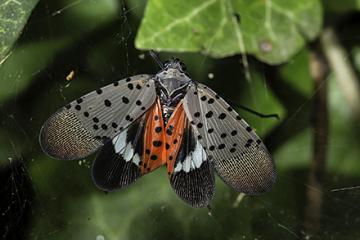Spotted Lanternfly Reveals a Potential Weakness
Scientists have discovered that the spotted lanternfly, an invasive threat to fruit crops and many trees, may have an Achilles heel – an attraction to vibration.
A native of China, the insect was discovered in Pennsylvania in 2014 and has since spread to 16 other states. Though beautiful as an adult, the insect is a voracious eater that feeds on woody and ornamental trees as well as a wide variety of crops and plants.
According to Richard Mankin, an entomologist with the Agricultural Research Service’s Center for Medical, Agricultural, and Veterinary Entomology in Gainesville, FL, spotted lanternfly has the potential to be an agroeconomic nightmare. Left unchecked, he said, Pennsylvania alone could lose hundreds of millions of dollars and thousands of jobs.
Fortunately, Mankin and two research colleagues (Barukh Rohde, postdoctoral researcher at the University of New Hampshire, and Miriam Cooperband, entomologist with USDA’s Animal and Plant Health Inspection Service) found a way to potentially corral and control the pests. Their research was published in the Journal of Economic Entomology.
“[Spotted lanternfly] can be controlled with pesticide, but spraying grapevines is problematic, so there is need for other control methods,” Mankin said. “There were rumors that lanternflies are attracted to vibrations of buzzing electrical power lines, so we did a laboratory study of nymph and adult responses to 60-cycle (60Hz) vibrations. The rumor proved to be correct! Both nymphs and adults walked towards the source of [the] vibrations.”
Using vibration to entice the lanternflies to gather is a major step toward improving control methods, including traps. Mankin said that further research will focus on finding ways to disrupt spotted lanternfly mating behavior.
Vibrations may not disrupt all spotted lanternfly mating in vineyards, but there have been some positive results in studies with other similar pests. Mankin said that scientists have recently achieved mating disruption of grapevine pests (leafhoppers and glassy winged sharpshooters) in Italy and California, respectively, by sending vibrations along grapevine wires. Grapes are commonly grown with their vines hanging from suspended wires.
Mankin has experience with disrupting the mating behavior of invasive pests. He and Rohde previously co-authored papers that explained how vibrations could mimic the “mating calls” of Asian citrus psyllid (ACP) to trap them and disrupt their mating behavior.
Successful development of an integrated pest management program could result in growers using less insecticide applications – saving time, energy, and money. It could also help reduce risk of pesticide exposure to pollinators and other inadvertent impacts to the environment. – by Scott Elliott, ARS Office of Communications


